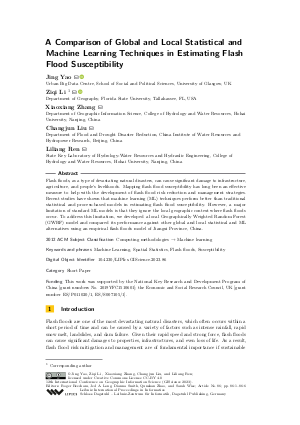A Comparison of Global and Local Statistical and Machine Learning Techniques in Estimating Flash Flood Susceptibility (Short Paper)
Authors
Jing Yao  ,
Ziqi Li
,
Ziqi Li  ,
Xiaoxiang Zhang,
Changjun Liu,
Liliang Ren
,
Xiaoxiang Zhang,
Changjun Liu,
Liliang Ren
-
Part of:
Volume:
12th International Conference on Geographic Information Science (GIScience 2023)
Part of: Series: Leibniz International Proceedings in Informatics (LIPIcs)
Part of: Conference: International Conference on Geographic Information Science (GIScience) - License:
 Creative Commons Attribution 4.0 International license
Creative Commons Attribution 4.0 International license
- Publication Date: 2023-09-07
File

PDF
LIPIcs.GIScience.2023.86.pdf
- Filesize: 1.07 MB
- 6 pages
Document Identifiers
Subject Classification
ACM Subject Classification
- Computing methodologies → Machine learning
Keywords
- Machine Learning
- Spatial Statistics
- Flash floods
- Susceptibility
Metrics
- Access Statistics
-
Total Accesses (updated on a weekly basis)
0PDF Downloads0Metadata Views
Abstract
Flash floods, as a type of devastating natural disasters, can cause significant damage to infrastructure, agriculture, and people’s livelihoods. Mapping flash flood susceptibility has long been an effective measure to help with the development of flash flood risk reduction and management strategies. Recent studies have shown that machine learning (ML) techniques perform better than traditional statistical and process-based models in estimating flash flood susceptibility. However, a major limitation of standard ML models is that they ignore the local geographic context where flash floods occur. To address this limitation, we developed a local Geographically Weighted Random Forest (GWRF) model and compared its performance against other global and local statistical and ML alternatives using an empirical flash floods model of Jiangxi Province, China.
Cite As Get BibTex
Jing Yao, Ziqi Li, Xiaoxiang Zhang, Changjun Liu, and Liliang Ren. A Comparison of Global and Local Statistical and Machine Learning Techniques in Estimating Flash Flood Susceptibility (Short Paper). In 12th International Conference on Geographic Information Science (GIScience 2023). Leibniz International Proceedings in Informatics (LIPIcs), Volume 277, pp. 86:1-86:6, Schloss Dagstuhl – Leibniz-Zentrum für Informatik (2023)
https://doi.org/10.4230/LIPIcs.GIScience.2023.86
BibTex
@InProceedings{yao_et_al:LIPIcs.GIScience.2023.86,
author = {Yao, Jing and Li, Ziqi and Zhang, Xiaoxiang and Liu, Changjun and Ren, Liliang},
title = {{A Comparison of Global and Local Statistical and Machine Learning Techniques in Estimating Flash Flood Susceptibility}},
booktitle = {12th International Conference on Geographic Information Science (GIScience 2023)},
pages = {86:1--86:6},
series = {Leibniz International Proceedings in Informatics (LIPIcs)},
ISBN = {978-3-95977-288-4},
ISSN = {1868-8969},
year = {2023},
volume = {277},
editor = {Beecham, Roger and Long, Jed A. and Smith, Dianna and Zhao, Qunshan and Wise, Sarah},
publisher = {Schloss Dagstuhl -- Leibniz-Zentrum f{\"u}r Informatik},
address = {Dagstuhl, Germany},
URL = {https://drops.dagstuhl.de/entities/document/10.4230/LIPIcs.GIScience.2023.86},
URN = {urn:nbn:de:0030-drops-189815},
doi = {10.4230/LIPIcs.GIScience.2023.86},
annote = {Keywords: Machine Learning, Spatial Statistics, Flash floods, Susceptibility}
}
Author Details
- Department of Geographic Information Science, College of Hydrology and Water Resources, Hohai University, Nanjing, China
- Department of Flood and Drought Disaster Reduction, China Institute of Water Resources and Hydropower Research, Beijing, China
Funding
This work was supported by the National Key Research and Development Program of China [grant numbers No. 2019YFC1510601]; the Economic and Social Research Council, UK [grant number ES/P011020/1, ES/S007105/1].
References
-
Jialei Chen, Guoru Huang, and Wenjie Chen. Towards better flood risk management: Assessing flood risk and investigating the potential mechanism based on machine learning models. Journal of environmental management, 293:112810, 2021.

-
Romulus Costache, Haoyuan Hong, and Quoc Bao Pham. Comparative assessment of the flash-flood potential within small mountain catchments using bivariate statistics and their novel hybrid integration with machine learning models. Science of The Total Environment, 711:134514, 2020.

-
Stefanos Georganos, Tais Grippa, Assane Niang Gadiaga, Catherine Linard, Moritz Lennert, Sabine Vanhuysse, Nicholus Mboga, Eléonore Wolff, and Stamatis Kalogirou. Geographical random forests: a spatial extension of the random forest algorithm to address spatial heterogeneity in remote sensing and population modelling. Geocarto International, 36(2):121-136, 2021.

-
Stefanos Georganos and Stamatis Kalogirou. A forest of forests: A spatially weighted and computationally efficient formulation of geographical random forests. ISPRS International Journal of Geo-Information, 11(9):471, 2022.

-
Julian Hagenauer and Marco Helbich. A geographically weighted artificial neural network. International Journal of Geographical Information Science, 36(2):215-235, 2022.

-
Khabat Khosravi, Hamid Reza Pourghasemi, Kamran Chapi, and Masoumeh Bahri. Flash flood susceptibility analysis and its mapping using different bivariate models in iran: a comparison between shannon’s entropy, statistical index, and weighting factor models. Environmental monitoring and assessment, 188:1-21, 2016.

-
Ziqi Li. Extracting spatial effects from machine learning model using local interpretation method: An example of shap and xgboost. Computers, Environment and Urban Systems, 96:101845, 2022.

-
Meihong Ma, Changjun Liu, Gang Zhao, Hongjie Xie, Pengfei Jia, Dacheng Wang, Huixiao Wang, and Yang Hong. Flash flood risk analysis based on machine learning techniques in the yunnan province, china. Remote Sensing, 11(2):170, 2019.

-
Amir Mosavi, Pinar Ozturk, and Kwok-wing Chau. Flood prediction using machine learning models: Literature review. Water, 10(11):1536, 2018.

-
Taylor M Oshan, Ziqi Li, Wei Kang, Levi J Wolf, and A Stewart Fotheringham. mgwr: A python implementation of multiscale geographically weighted regression for investigating process spatial heterogeneity and scale. ISPRS International Journal of Geo-Information, 8(6):269, 2019.

-
Fabian Pedregosa, Gaël Varoquaux, Alexandre Gramfort, Vincent Michel, Bertrand Thirion, Olivier Grisel, Mathieu Blondel, Peter Prettenhofer, Ron Weiss, Vincent Dubourg, et al. Scikit-learn: Machine learning in python. the Journal of machine Learning research, 12:2825-2830, 2011.

-
Binh Thai Pham, Mohammadtaghi Avand, Saeid Janizadeh, Tran Van Phong, Nadhir Al-Ansari, Lanh Si Ho, Sumit Das, Hiep Van Le, Ata Amini, Saeid Khosrobeigi Bozchaloei, et al. Gis based hybrid computational approaches for flash flood susceptibility assessment. Water, 12(3):683, 2020.

-
Seann Reed, John Schaake, and Ziya Zhang. A distributed hydrologic model and threshold frequency-based method for flash flood forecasting at ungauged locations. Journal of hydrology, 337(3-4):402-420, 2007.

